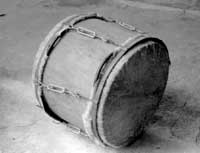1. START
2. INTRODUCTION
3. MUSICAL CHARACTERISTICS
The musical charcteristics, form/structure, rhythm and cadences of an ura pa'u.
4. PERFORMANCE
Performaning the ura pa'u.
5. INSTRUMENTS
The instrumentation of an ura pa'u.
<<Previous | Page 1 2 3 4 5 | Next>>
MUSICAL CHARACTERISTICS
The ura pa'u is a show of the virtuosity of both the musicians and dancers. It is fast in tempo and very vigorous. It is often referred to as the "symphony of drums", and is probably one of the best known musical forms in the Pacific.

A pa'u mango.
FORM/STRUCTURE
The ura pa'u is divided into three sections:
Introduction: the musical material of the entrance (ki mua) and exit (ki muri) is identical. It is stereotyped and used at any time the dancers arrive or leave the performance space. This music can be used as a bridge between items in a show.
Warm-up: "akatikatika". This serves as an introduction to the "dance proper". The dancers make use of this time to "straighten up" into their first formation. The musicians benefit from this warm up. If a pe'e is used as a starting point for the ura pa'u, it is introduced at this point.
Dance proper (ura pa'u): the dance is performed. Subsections are defined by the use of male, female, or mixed dance. The dances in this section are symmetrical, with dancers in matched pairs wherever possible. The actions are also symmetrical using both side of the body. There is always a balance between up and down, left and right. The choreographer also considers balanced use of the performance space.

A pa'u.
RHYTHM
Stereotyped rhythms feature. The pa'u plays a pulse (sometimes decorated) throughout, with rests in some sections. This is the simplest instrumental part.
The pa'u mango plays an ostinato pattern throughout, with rests in some sections.
The pate play the most complex part, often polyphonic, sometimes monophonic. This part is characterised by the use of running semiquavers (in the leaders part) and repetitive patterns in the other pate parts. Because of the fast tempo, a high degree of virtuosity is required.
Standard time signatures are difficult to apply to ura pa'u.
CADENCES
Rhythmic "cadences" occur at the end of a section. They indicate a repetition of a preceding section, or the start of a new one. There is no aural difference between the two.
What is an ura pa'u?
Name the instruments that would be used to perform an ura pa'u.
How many sections are usually found in an ura pa'u?
© jeni little | chimaera 2010 | rights reserved
